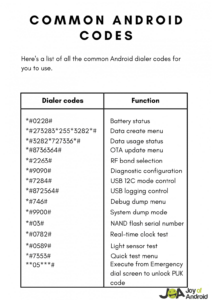Ultimate Guide: 5 Powerful Ways to Master Android’s Split-Screen Feature
Related Articles: Ultimate Guide: 5 Powerful Ways to Master Android’s Split-Screen Feature
- Effortless 5-Step Guide To Recover Deleted Files On Android: No Data Loss Panic!
- Ultimate Guide: 5 Powerful Ways To Transform Your Android Home Screen
- Ultimate Guide: 10 Powerful Ways To Free Up Android Storage
- Ultimate 7-Step Guide To Effortlessly Find Your Lost Android Phone
- Unleash The Power! 10 Awesome Hidden Android Features You Need To Know
Introduction
With great pleasure, we will explore the intriguing topic related to Ultimate Guide: 5 Powerful Ways to Master Android’s Split-Screen Feature. Let’s weave interesting information and offer fresh perspectives to the readers.
Table of Content
- 1 Related Articles: Ultimate Guide: 5 Powerful Ways to Master Android’s Split-Screen Feature
- 2 Introduction
- 3 Ultimate Guide: 5 Powerful Ways to Master Android’s Split-Screen Feature
- 3.1 1. The Classic Swipe Method: A Simple Start
- 3.2 2. The Power Button Shortcut: A Quick and Convenient Approach
- 3.3 3. The Multi-Window Button: A Dedicated Button for Multitasking
- 3.4 4. The App Drawer Shortcut: A Direct Approach for Multiple Apps
- 3.5 5. The Floating App Shortcut: A Versatile and Powerful Option
- 3.6 Beyond the Basics: Optimizing Split-Screen Mode for Maximum Productivity
- 3.7 Conclusion: Embracing the Power of Multitasking
- 4 Closure
Ultimate Guide: 5 Powerful Ways to Master Android’s Split-Screen Feature

Android’s split-screen feature is a game-changer for multitasking, allowing you to use two apps simultaneously on your device. Whether you’re a power user juggling multiple tasks or just looking for a more efficient way to browse the web while listening to music, split-screen mode can significantly enhance your productivity.
This comprehensive guide will take you through the intricacies of this powerful feature, exploring five different methods to activate and utilize split-screen mode on your Android device. From the basic steps to advanced customization options, we’ll equip you with the knowledge to unlock the full potential of this multitasking marvel.
1. The Classic Swipe Method: A Simple Start
The most common and straightforward way to enter split-screen mode is through the intuitive swipe gesture. This method works on most Android devices running Android 7.0 Nougat or later. Here’s how to do it:
-
Open the first app you want to use in split-screen mode. This can be any app, from a messaging app to a web browser.
-
Tap the "Recent Apps" button. This is usually a square or a rectangle located at the bottom of your screen.
-
Locate the app preview you want to use alongside your current app.
-
Tap and hold the app preview. You’ll see a pop-up menu with different options.
-
Select "Open in split screen view." This will instantly split your screen, placing the chosen app in the top half of the screen while the original app remains in the bottom half.

Customization Options:
-
Resize the split: Drag the divider between the two app windows to adjust the size of each app according to your preference.

Switch app positions: Tap the "Switch apps" button (usually a small arrow icon) located at the bottom of the screen to swap the positions of the apps.
-
Exit split-screen: Tap the "Exit split-screen" button (usually a small "X" icon) at the top of the screen to return to a single-screen view.
2. The Power Button Shortcut: A Quick and Convenient Approach
For those who prefer a more direct approach, Android offers a convenient shortcut using the power button. This method is especially useful when you’re already within an app and want to quickly switch to another one in split-screen mode.
-
Open the first app you want to use in split-screen mode.
-
Press and hold the power button. A menu will appear with options like power off, restart, and more.
-
Select "Split screen view." This will open a list of recently used apps.
-
Choose the app you want to use alongside your current app. The selected app will immediately open in split-screen mode, taking up the top half of the screen.
Customization Options:
- Customize the power button menu: Depending on your device and Android version, you might be able to customize the power button menu to include additional shortcuts, such as split-screen view or other actions.
3. The Multi-Window Button: A Dedicated Button for Multitasking
Some Android devices, especially those running newer versions of Android, come equipped with a dedicated "Multi-Window" button. This button provides a quick and convenient way to access split-screen mode and other multitasking features.
-
Open the first app you want to use in split-screen mode.
-
Locate the "Multi-Window" button. This button is usually located on the navigation bar or within the quick settings panel.
-
Tap the "Multi-Window" button. A list of recently used apps will appear.
-
Choose the app you want to use alongside your current app. The selected app will open in split-screen mode.
Customization Options:
-
Change the button’s location: On some devices, you can customize the location of the "Multi-Window" button to suit your preferences.
-
Explore other multitasking features: The "Multi-Window" button often provides access to other multitasking features, such as picture-in-picture mode or floating windows.
4. The App Drawer Shortcut: A Direct Approach for Multiple Apps
If you prefer a more direct approach to selecting your split-screen partners, the app drawer offers a convenient shortcut. This method allows you to choose any app from your app drawer to open in split-screen mode.
-
Open the app you want to use in split-screen mode.
-
Open the app drawer. This is usually accessed by swiping up from the bottom of the screen.
-
Long-press the app you want to open in split-screen mode. A pop-up menu will appear.
-
Select "Open in split screen view." The chosen app will open in split-screen mode alongside your currently open app.
Customization Options:
- Use the "App Info" menu: You can also access the "Open in split screen view" option by going to the app’s "App Info" menu.
5. The Floating App Shortcut: A Versatile and Powerful Option
For those who prefer a more dynamic and flexible multitasking experience, the floating app shortcut offers a unique approach to split-screen mode. This method allows you to open an app in a floating window, which can be resized and moved around the screen.
-
Open the app you want to use in split-screen mode.
-
Open the "Recent Apps" menu.
-
Locate the app preview you want to use in floating mode.
-
Tap the "Floating window" button. This button is usually located at the top of the app preview.
-
Resize and move the floating window: You can resize the floating window by dragging the corners and move it around the screen by dragging the app icon.
-
Convert to split-screen mode: You can convert the floating window to split-screen mode by dragging it to the top or bottom of the screen.
Customization Options:
-
Customize floating window size and position: You can adjust the size and position of the floating window to suit your needs.
-
Use multiple floating windows: You can open multiple apps in floating windows, allowing you to multitask with even greater flexibility.
Beyond the Basics: Optimizing Split-Screen Mode for Maximum Productivity
While the methods described above provide a solid foundation for utilizing split-screen mode, there are several additional tips and tricks to enhance your multitasking experience:
-
Customize the split-screen divider: On some devices, you can customize the appearance of the split-screen divider, changing its color or thickness to better suit your preferences.
-
Use keyboard shortcuts: Many apps offer keyboard shortcuts for common actions, making it even faster to navigate and interact with apps in split-screen mode.
-
Experiment with different app combinations: The beauty of split-screen mode lies in its flexibility. Don’t be afraid to experiment with different app combinations to find the most efficient workflow for your specific needs.
-
Consider using a stylus: If your device supports a stylus, you can use it to interact with apps in split-screen mode with greater precision and control.
Conclusion: Embracing the Power of Multitasking
Android’s split-screen feature is a powerful tool that can significantly enhance your productivity and multitasking capabilities. By mastering the different methods to activate and utilize split-screen mode, you can unlock a world of possibilities for efficient and seamless multitasking on your Android device.
Whether you’re a student juggling multiple assignments, a professional managing multiple projects, or simply looking for a more convenient way to browse the web while listening to music, split-screen mode is an invaluable asset for anyone seeking to maximize their productivity.
Embrace the power of multitasking and take your Android experience to the next level with this versatile and intuitive feature.
Closure
Thus, we hope this article has provided valuable insights into Ultimate Guide: 5 Powerful Ways to Master Android’s Split-Screen Feature. We thank you for taking the time to read this article. See you in our next article!
google.com




